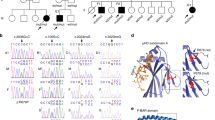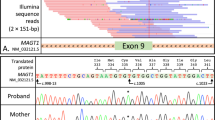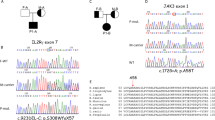Abstract
The T–cell receptor (TCR) is composed of two glycoproteins (α and β or γ and δ) associated with four invariant polypeptides (CD3–γ, δ, ε and ζ). The majority of TCR/CD3 complexes contain six polypeptide chains, and although there is some flexibility in the complex subunit stoichiometry the CD3–ε chain is central to CD3 core assembly and full complex formation. We have described previously defective expression of the TCR/CD3 complex in an immunodeficient child. We now report that two independent CD3–ε gene mutations present in the parents have segregated in the patient, leading to defective CD3–ε chain synthesis and preventing normal association and membrane expression of the TCR/CD3 complex.
This is a preview of subscription content, access via your institution
Access options
Subscribe to this journal
Receive 12 print issues and online access
$209.00 per year
only $17.42 per issue
Buy this article
- Purchase on Springer Link
- Instant access to full article PDF
Prices may be subject to local taxes which are calculated during checkout
Similar content being viewed by others
References
Ashwell, J.D. & Klausner, R.D. Genetic and mutationnal analysis of the T-cell antigen receptor. Annu. Rev. Immunol. 8, 139–167 (1990).
Clevers, H., Alarcon, B., Wileman, T. & Terhorst, C. The T cell receptor/CD3 complex: a dynamic protein ensemble. Ann. Rev. Immunol. 6, 629–662 (1988).
Klausner, R.D., Lippincott-Schwartz, J. & Bonifacino, J.S. The T Cell antigen receptor: insight into organelle biology. Ann. Rev. cell. Biol. 6, 403–431 (1990).
Tunnacliffe, A., Buluwela, L. & Rabbitts, T.H. Physical linkage of three CDS genes on human chromosome 11. EMBO J. 6, 2953–2957 (1987).
Clevers, H.C., Dunlap, S., Wileman, T.E. & Terhorst, C. Human CD3-ε gene contains three miniexons and is transcribed from a non-TATA promoter. Proc. natn. Acad. Sci. U.S.A. 85, 8156–8160 (1988).
Clevers, H., Lonberg, N., Dunlap, S., Lacy, E. & Terhorst, C. An enhancer located in a CpG-island 3′ to the TCR/CD3-ε gene confers T lymphocyte-specificity to its promoter. EMBO J. 8, 2527–2535 (1989).
Hall, C., Berkhout, B., Sancho, J., Wileman, T. & Terhorst, C. Requirements for cell surface expression of the human TCR/CD3 complex in non-T cells. Int. Immunol. 3, 359–368 (1991).
Wileman, T., Carson, G.R., Concino, M., Ahmed, A. & Terhorst, C. The γ and ε subunits of the CDS complex inhibit pre-golgi degradation of newly synthesized T cell antigen receptors. J. cell Biol. 110, 973 (1990).
Blumberg, R.S. et al. Structure of the T-cell antigen receptor: evidence for two CDS-ε subunits in the T-cell receptor-CDS complex. Proc. natn. Acad. Sci. U.S.A. 87, 7220–7224 (1990).
Blumberg, R.S. et al. Assembly and function of the T cell antigen receptor. J. biol. Chem. 265, 14036–14043 (1990).
Jin, Y. et al. A fraction of CD3-ε subunits exists as disulfide-linked dinners in both human and murine T lymphocytes. J. biol. Chem. 265, 15850–15853 (1990).
Arnaiz-Vilena, A. et al. Biochemical basis of a novel T lymphocyte receptor immunodeficiency by immunochemistry. Lab. Invest. 64, 675–681 (1991).
Arnaiz-Villena, A. et al. Brief report: primary immunodeficiency caused by mutations in the gene encoding the CD3-γ subunit of the T-lymphocyte receptor. New Engl. J. Med. 327, 529–533 (1992).
Perez-Aciego, P. et al. Expression and function of a variant T cell Receptor complex lacking CD3-γ. J. exp. Med. 174, 319–326 (1991).
Le Deist, F., Thoenes, G., Corado, J., Lisowska-Grospierre, B. & Fischer, A. Immunodeficiency with low expression of the T cell receptor/CD3 complex. Effect on T lymphocytes activation. Eur. J. Immunol. 21, 1641–1647 (1991).
Thoenes, G. et al. Structural analysis of low TCR/CD3 complex expression in T cells of an immunodeficient patient. J. biol. Chem. 267, 487–493 (1992).
Alcover, A., Maruizza, R.A., Ermonval, M. & Acuto, O. Lysine 271 in the transmembrane domain of the T cell antigen receptor is necessary for its assembly with the CDS complex but not for α\β dimerization. J. biol. Chem. 265, 4131–4135 (1990).
Tan, L., Turner, J. & Weiss, A. Regions of the T cell receptor α and β chains that are responsible for interactions with CDS. J. exp. Med. 173, 1247–1256 (1991).
Mallabiabarrena, A., Fresno, M. & Alarcon, B. An endoplasmic reticulum retention signal in the CD3-ε chain of the T-cell receptor. Nature 357, 593–596 (1992).
Vidaud, M. et al. A 5′ splice-region G-C mutation in exon 1 of the human b-globin gene inhibits pre-mRNA splicing: A mechanism for β+-halassemia. Proc. natn. Acad. Sci. U.S.A. 86, 1041–1045 (1989).
Dianzani, I. et al. Screening for mutations in the Phenylalanine Hydroxylase gene from Italian patients with Phenylketonuria by using the chemical cleavage method: a new splice mutation. Am. J. hum. Genet. 48, 631–635 (1991).
Kishimoto, T.K., O'Connor, K. & Springer, T.A. Leukocyte Adhesion Deficiency. J. biol. Chem. 264, 3588–3595 (1989).
Back, A.L., Kwok, W.W. & Hickstein, D.D. Identification of two molecular defects in a child with leukocyte adherence deficiency. J. biol. Chem. 267, 5482–5487 (1992).
Aebi, M., Horning, H., Padgett, R.A., Reiser, J. & Weissmann, C. Sequence requirements for splicing of higher eukaryotic nuclear pre-mRNA. Cell 47, 555–565 (1986).
Akli, S., Chelly, J., Lacorte, J-M., Poenaru, L. & Kahn, A. Seven novel Tay-Sachs mutations detected by chemical mismatch cleavage of PCR-amplified cDNA fragments. Genomics 11, 124–134 (1991).
Baserga, S.J. & Benz, E.J. Jr. Nonsense mutations in the human β-globin gene affect mRNA metabolism. Proc. natn. Acad. Sci. U.S.A. 85, 2056–2060 (1988).
Liebhaber, S.A., Coleman, M.B., Adams, J.G., Cash, F.E. & Steinberg, M.H. Molecular basis for non deletion α Thalassemia in american blacks. J. clin. Invest. 80, 154–159 (1987).
Baserga, S., Edward, J. & Benz, E.J. Jr. β-globin nonsense mutation: deficient accumulation of mRNA occurs despite normal cytoplasmic stability. Proc. natn. Acad. Sci. U.S.A. 89, 2935–2939 (1992).
Kashii, S. et al. Adenosine deaminase deficiency due to hetrozygous abnormality consisting of a deletion of exon 7 and the absence of enzyme mRNA. J. cell. Biochem. 47, 49–53 (1991).
Faustinella, F. et al. Catalytic triad residue mutation (Asp156>Gly) causing familail lipoprotein lipase deficiency. J. biol. Chem. 266, 14418–14424 (1991).
Gotoda, T. et al. Occurence of multiple aberrently spliced mRNAs upon a donnor splice site mutation that causes familial lipoprotein lipase deficiency. J. biol. Chem. 266, 24757–24762 (1991).
Ohno, K. & Suzuki, K. Multiple abnormal β-hexosaminidase α chain mRNA as in a compound-heterozygous ashkenazi Jewish patient with Tay-Sachs disease. J. biol. Chem. 263, 18563–18567 (1988).
Alarcon, B. et al. The CD3-γ and CD3-δ subunits of the T cell antigen receptor can be expressed within distinct functional TCR/CD3 complexes. EMBO J. 10, 903–912 (1991).
Kapes, D.J. & Tonegawa, S. Surface expression of alternative forms of the TCR/CD3 complex. Proc. natn. Acad. Sci. U.S.A. 88, 10619–10623 (1991).
Buferne, M. et al. Role of CD3-δ in surface expression of the TCR/CD3 complex and in activation for killing analysed with a CD3-δ-negative cytotoxic T lymphocyte variant. J. Immunol. 148, 657–664 (1992).
Gold, D.P. et al. Isolation of cDNA clones encoding the 20K non-glycosylated polypeptide chain of the human T-cell receptor/T3 complex. Nature 321, 431–434 (1986).
Author information
Authors and Affiliations
Rights and permissions
About this article
Cite this article
Soudais, C., de Villartay, JP., Le Deist, F. et al. Independent mutations of the human CD3–ε gene resulting in a T cell receptor/CD3 complex immunodeficiency. Nat Genet 3, 77–81 (1993). https://doi.org/10.1038/ng0193-77
Received:
Accepted:
Issue Date:
DOI: https://doi.org/10.1038/ng0193-77
This article is cited by
-
A Novel Biallelic LCK Variant Resulting in Profound T-Cell Immune Deficiency and Review of the Literature
Journal of Clinical Immunology (2024)
-
Biallelic Form of a Known CD3E Mutation in a Patient with Severe Combined Immunodeficiency
Journal of Clinical Immunology (2020)
-
Meta-analysis of genomic variants and gene expression data in schizophrenia suggests the potential need for adjunctive therapeutic interventions for neuropsychiatric disorders
Journal of Genetics (2019)
-
A novel pathogenic frameshift variant of CD3E gene in two T-B+ NK+ SCID patients from Turkey
Immunogenetics (2017)
-
Severe combined immunodeficiencies and related disorders
Nature Reviews Disease Primers (2015)



